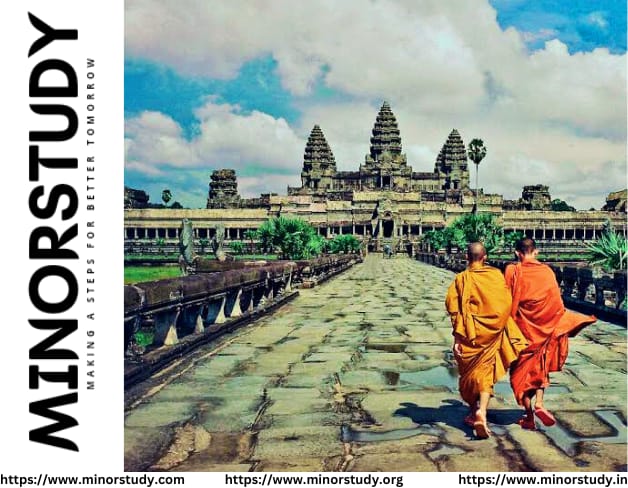🛕 Introduction: A Wonder That Transcends Time
Tucked within the dense jungles of Siem Reap, Cambodia, the Angkor Wat temple complex is not just the pride of Cambodia—it’s the soul of an entire civilization. This UNESCO World Heritage Site, recognized globally as the largest religious monument in the world, draws in travelers, historians, spiritual seekers, and photographers from every corner of the globe.
- 🛕 Introduction: A Wonder That Transcends Time
- 🏛️ History of Angkor Wat
- 🗓️ Timeline of Angkor Wat: From Sacred Ground to Global Icon
- 📚 10 Surprising Facts About Angkor Wat
- ❓ Frequently Asked Questions (FAQs)
- 📍 Where is Angkor Wat located?
- 💰 Do I need a ticket to visit?
- ⏰ What’s the best time to visit Angkor Wat?
- 🛕 Is it a Hindu or Buddhist temple?
- 🏗️ How long did it take to build?
- ✨ Spiritual and Cultural Significance
- 🎊 Observances and Festivals at Angkor Wat
- 🎉 Heartfelt Wishing from Angkor’s Spirit
- 🧭 Why Angkor Wat Is Important in Our Lives Today
- 🔍 Important Points Recap
- 💫 Impact on Daily Life and Society
- 🏁 Conclusion: A Temple That Lives Beyond Time
Angkor Wat is far more than stone, carvings, and towers. It is a living symbol of devotion, resilience, and cultural brilliance—an embodiment of both spiritual enlightenment and architectural grandeur.
🏛️ History of Angkor Wat
The majestic Angkor Wat was originally built in the early 12th century by King Suryavarman II, during the height of the Khmer Empire. Intended as a Hindu temple dedicated to Lord Vishnu, Angkor Wat eventually evolved into a Buddhist temple in the 14th century—a transformation that mirrors Cambodia’s religious journey.
What makes Angkor Wat even more fascinating is that it wasn’t just a temple—it was a political capital, a religious sanctuary, and a royal mausoleum all in one.
🗓️ Timeline of Angkor Wat: From Sacred Ground to Global Icon
| Year | Event |
|---|---|
| 1113–1150 CE | Construction under King Suryavarman II |
| 1177 | Invaded by Chams (enemies of Khmer) |
| 1181–1220 | King Jayavarman VII converts empire to Buddhism |
| 14th century | Angkor Wat becomes a Theravāda Buddhist temple |
| 1860 | Rediscovered by French naturalist Henri Mouhot |
| 1992 | Listed as a UNESCO World Heritage Site |
| 21st century | Undergoes global restoration efforts |
📚 10 Surprising Facts About Angkor Wat
It’s the largest religious monument on Earth, covering over 162 hectares (402 acres).
The name “Angkor Wat” means “City of Temples” in Khmer.
Its construction used 5 million to 10 million sandstone blocks, each weighing up to 1.5 tons.
The entire temple faces west, unusual for Hindu temples (often east-facing), possibly symbolizing death and afterlife.
It is adorned with over 3,000 heavenly nymphs (apsaras) carved on its walls.
Angkor Wat appears on the Cambodian national flag—the only flag in the world with a temple on it.
The complex has bas-reliefs that stretch over 800 meters, depicting stories from Ramayana and Mahabharata.
No mortar was used—blocks were perfectly cut to interlock.
Rediscovered in the 19th century, it had been hidden by jungle and time.
Today, it’s considered both a spiritual pilgrimage site and a tourism powerhouse.
❓ Frequently Asked Questions (FAQs)
📍 Where is Angkor Wat located?
Angkor Wat is located in Siem Reap province, in northwestern Cambodia.
💰 Do I need a ticket to visit?
Yes, visitors need to purchase the Angkor Pass, which grants access to all the major temples in the Angkor Archaeological Park.
⏰ What’s the best time to visit Angkor Wat?
Early morning (sunrise) is magical. The dry season (November to March) is the most pleasant for travel.
🛕 Is it a Hindu or Buddhist temple?
Originally Hindu, but now Buddhist. It has elements of both traditions in its design and symbolism.
🏗️ How long did it take to build?
It is believed that construction took approximately 30 years to complete.
✨ Spiritual and Cultural Significance
Angkor Wat is more than a masterpiece of stone—it is a spiritual anchor. For centuries, it has remained a place where divine energy meets earthly ambition.
🔱 Hindu Legacy
The temple was dedicated to Lord Vishnu, and its layout represents Mount Meru, the cosmic mountain in Hindu mythology. Its five towers symbolize the five peaks of Meru, and the surrounding moat represents the cosmic ocean.
🕉️ Buddhist Transformation
After Cambodia transitioned to Buddhism, statues of the Buddha were added. Even today, Buddhist monks can be seen praying or meditating in its sacred corridors.
🎊 Observances and Festivals at Angkor Wat
Angkor Sangkran (Khmer New Year) – Celebrated in April, with traditional games, blessings, and temple rituals.
Visak Bochea Day – Celebrates the birth, enlightenment, and death of Buddha.
Pchum Ben (Ancestor’s Day) – A time when Cambodians visit temples to honor their ancestors.
These festivals bring Angkor Wat to life, filled with chants, incense, offerings, and heartfelt prayers from local communities.
🎉 Heartfelt Wishing from Angkor’s Spirit
“May your journey through life be as serene and steady as the stones of Angkor Wat. May the light of its ancient towers guide your heart to peace, strength, and spiritual truth.”
Whether you’re Buddhist, Hindu, or a lover of heritage, the blessings of Angkor Wat transcend religion.
🧭 Why Angkor Wat Is Important in Our Lives Today
🧘♂️ A Space for Reflection
In our fast-paced digital age, Angkor Wat offers a rare space to pause, reflect, and reconnect with something ancient and pure. Walking through its silent galleries often becomes a meditative experience.
👨👩👧 A Legacy for Future Generations
It educates young people about mythology, architecture, environmental sustainability, and culture, fostering a deep respect for history and art.
🤝 A Global Connection
Angkor Wat is one of the most visited landmarks in Southeast Asia, welcoming over 2 million visitors annually (pre-pandemic), thus fostering cross-cultural dialogue and tourism-based livelihoods.
🔍 Important Points Recap
Built in the 12th century by King Suryavarman II
World’s largest religious structure
Symbol of both Hindu and Buddhist heritages
Architecturally represents cosmic harmony
Now a UNESCO World Heritage Site
Major driver of Cambodia’s economy and identity
💫 Impact on Daily Life and Society
🇰🇭 National Identity
Angkor Wat is not just a relic of the past—it is present on Cambodia’s flag, currency, and consciousness. It’s a source of national pride and unity.
🌍 Global Inspiration
Artists, architects, spiritual leaders, and tourists alike find deep inspiration in its balance of symmetry, symbolism, and serenity.
💼 Economic Lifeline
Tourism linked to Angkor Wat supports thousands of local families through hotels, guiding services, crafts, and conservation work.
🛠️ Cultural Conservation
Ongoing restoration, funded by international agencies, teaches us the importance of preserving our collective world heritage for future generations.
🏁 Conclusion: A Temple That Lives Beyond Time
Angkor Wat is not just ancient—it’s eternal. It’s a space where stone breathes life, and myth meets memory. It teaches us that beauty, when rooted in spirituality and service, stands tall against the tides of time.
In every carved corner, Angkor Wat whispers stories of gods, kings, and everyday people who believed in purpose beyond self. It tells us to build lives not only of success but of meaning.









Hi there, You’ve done a fantastic job. I will certainly digg it and personally recommend to my friends. I’m confident they’ll be benefited from this website.